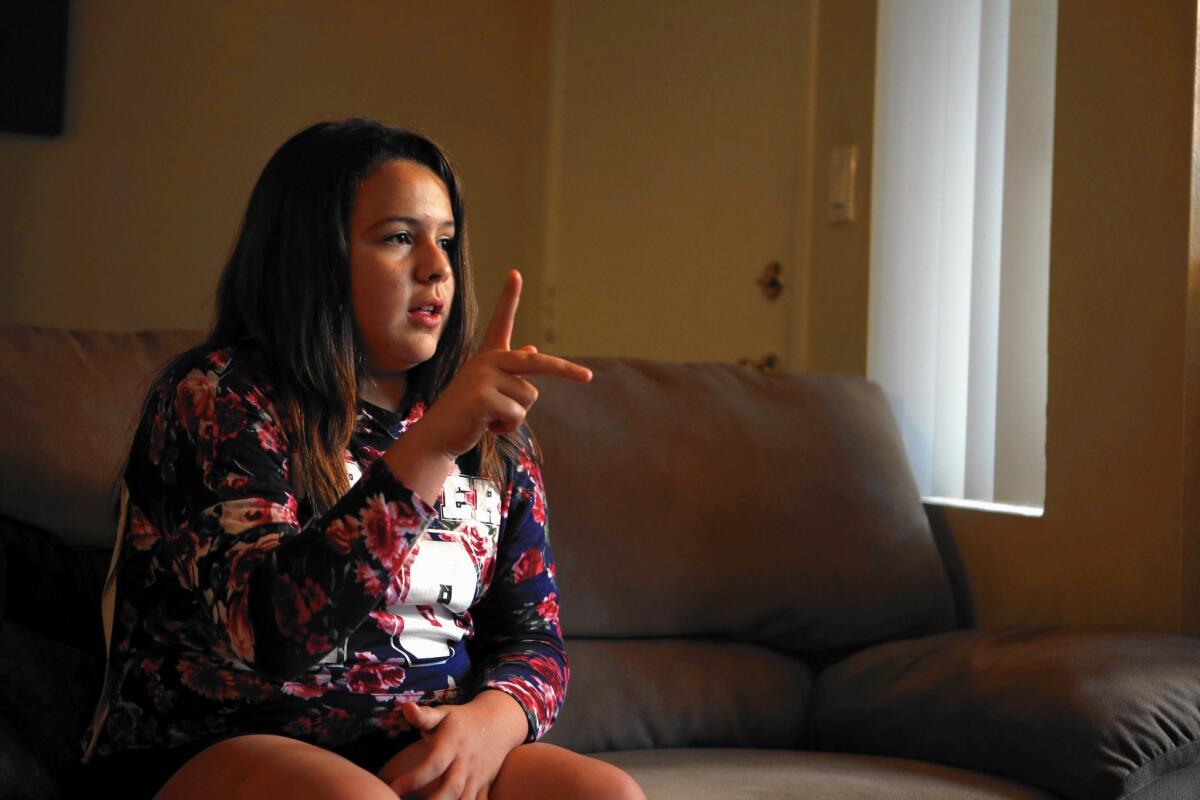Why it’s no small feat that these hearing-impaired kids made it to the national round of a reading competition

Diamond Scott is captain of the Sussman Middle School team competing in the Gallaudet University literacy battle.
Diamond Scott often communicates in two languages at the same time. While the sixth-grader speaks English out loud, she weaves sentences with her hands, whooshing her fingers into the lively shapes that form American Sign Language.
This weekend, as the captain of the Sussman Middle School literacy team, Diamond will use her hard-earned communication and reading skills to compete in the final round of the Battle of the Books, a literacy competition run by Gallaudet University.
This year marks the first time the Downey school has reached the competition’s national level. It’s the only team that includes students who learn with peers who don’t have hearing challenges; all the other teams come from specialized schools that teach students who are deaf.
In the 2014-2015 academic year, 13,844 students identified as deaf or hard of hearing in California, according to the state Department of Education.
Many of these students start off life having heard far fewer words than their peers. According to Rebecca Piepho-Su, the Los Angeles County Office of Education’s special education administrator who oversees deaf and hard-of-hearing programming in Sussman and other schools, there’s less incidental learning, creating an even greater gap that schools have to help close once students enter kindergarten.

A team of students who are deaf and hard of hearing in Downey is the only group of general education students in the United States to make it to the final round of Gallaudet University’s literacy competition.
Diamond is hard of hearing but can speak and listen with the help of hearing aids. Two fellow teammates are traveling with her to Gallaudet, the world’s only university for deaf students, in Washington, D.C. They’re in the blue division, meaning the group of students who read at a fourth- or fifth-grade level.
When Diamond presents her answer, she will use her voice, as will her friend Gabriela Rocha, and her friend Cindy Som will sign. Diamond prepared for the competition by reading “Loot,” a book about two siblings who first meet each other upon the death of their cat-burglar father and plan heists together. The work wasn’t easy.
“I have to read and reread again to understand it,” the 11-year-old said recently during a conversation at her Norwalk home.
Students who are deaf often learn American Sign Language, a system of visual signs that differs from spoken English language in syntax and other rules — so schools frequently try to help parents find ways to communicate with their children.
The Sussman program is administered by the Los Angeles County Office of Education, whose special education programs have faced criticism for poor instruction, teacher turnover and other issues. But the deaf and hard-of-hearing program is considered a bright spot, and the county hopes the competition will highlight that.
To advance to the national competition, the Sussman students had to answer questions about three books in real time while facing other schools. Holding discussions about a book in American Sign Language was complicated. Teachers used visual cues and role-play.
Words with multiple meanings, such as “fly,” are especially tricky, said teacher Koreen Husted.
David Ferrer, who graduated from Gallaudet, suggested the competition would be a good test for students.
The team was chosen using several criteria: zero absences, good behavior records, commitment to study group, high grades and positive teacher reports — and then the teachers set a rigorous reading schedule.
“We can’t just give them the book and say, ‘Go read,’” said Ferrer, a teacher with the county education office.
Students practiced as often as four days a week, during their lunch and snack periods.
For Diamond, practice became a way to bond with deaf students. When she was very young and learned she was hard of hearing, she was nervous that people would make fun of her. Mostly they haven’t, with the exception of some students who teased her for sitting in the front row in all her classes so that she could read the lips of her teachers.
Reading was a weak point for her in elementary school. Diamond, who calls herself a straight-A student, flunked. She had trouble understanding words and read slowly. Her mother invested in a tutor, and she improved. Now she’s representing her school.
When she grows up, she wants to be a WNBA star, she said.
Reyna Rocha’s daughter Gabriela, 14, Diamond’s teammate, was born profoundly deaf in both ears but can hear now after getting cochlear implants. At one time, Rocha said, Gabriela was the only deaf person at her elementary school.
Since switching to Sussman, her daughter is much happier, Rocha said.
“She’s a positive girl and she never said no and always learned,” she said, speaking in Spanish. “It makes me sad that there are barriers for her, but we have a lot of communication and support.”
Twitter: @Joy_Resmovits
ALSO
Library of Congress to stop using ‘illegal alien’
On campuses across the country, students are standing up for Donald Trump
More to Read
Start your day right
Sign up for Essential California for news, features and recommendations from the L.A. Times and beyond in your inbox six days a week.
You may occasionally receive promotional content from the Los Angeles Times.







